As I prepare my manuscript package for submission to editors and agents, I — like many writers before me — got stuck at the synopsis. It doesn’t seem fair, does it, that we somehow have to condense 80,000 to 100,000 words into 1,000 words or less. Think of all the interesting characters and subplots and this-plots and that-plots that we have to leave out! And someone is going to judge our stories based on this little document. The outrage is real, and it seems like a crime against humanity.
But it’s not.
Agents and editors receive so many submissions, they need a fast way to to determine if the submitting author would be a good fit for what they know they can sell. But this post isn’t about how the synopsis is good for agents and editors. It’s about how it’s good for you and me, the writers and, by extension, the readers. Surprised? I was too. Let me tell you how I learned to stop hating and love the synopsis.
First, if I couldn’t explain the premise of my novel in a nutshell, then I probably didn’t understand it well myself. This is true of any kind of knowledge, really, not just writing. There are a lot of complicated concepts, and a good test of mastery is whether one can explain it to a five year-old. That is, if one can explain a complicated concept in simple terms, then one probably has a deep understanding of it. So that is what the synopsis is: it is an indication of mastery over one’s created work. As complex and interesting as it is, sometimes the nuances can be left out. Understanding which ones are necessary and which are beautiful filler (or worse: unproductive filler) is important. As a creator, it’s important to know which bits are necessary and which aren’t, especially when it comes to self-editing.
When I wrote my synopsis, it helped me really distill the ideas and themes in my novel down to the necessary. It helped me change the first two chapters of my novel for the better. I realized that the main idea was not clearly presented in the first chapter, and the first chapter of a novel is kind of like a thesis statement in a paper. It lets everyone know what it’s all about. If it’s clearly presented, the readers feel comfortable or taken care of by the writer. If it’s muddy, the readers feel ill-at-ease and suspicious of the writer, that perhaps they are not in very good hands. I want my readers to feel comfortable when they open my book, I want them to feel like I will take care of them, that I’ve put everything together and they don’t have to worry about the mechanics of the story. I want them to feel assured that it will be a good ride, that they just need to snuggle up in their favorite reading spot and be carried away. As a writer, I know everything about my characters, my world, my plot, both the written and unwritten. But the reader does not. I have to ask them to trust me, and I have to prove to the reader that I am trust-worthy. Trust is crucial. Writing my synopsis helped me trust myself as I ask a reader to trust me. I am grateful for that.
Self-editing is crucial for creatives. Too much of a good thing can be a bad thing, or a messy thing, or a what-the-crazy-that-makes-no-sense thing. Agents and editors use the synopsis to see if the writer has worked out all the kinks in the plot and character development. Writers can also use the synopsis for the same purpose. When I wrote my synopsis, I realized that the build-up to the climax was fantastic, but the climax itself was flat.
No one wants a flat climax. No one.
A climax should have boom, punch, zazz. You get the idea. A good creative work of any kind needs to be dynamic, and the climax to a story of fiction should be “ff af”, if I may borrow two expressions from related fields (i.e. music and internet comment threads). In other words, if I didn’t want my book to die on the table, I had to hit the flat-lining climax with adrenaline and shock it back to life. Writing the synopsis helped me see not only that the climax was dying, but also what it needed to be brought back to life.
So thank you, Synopsis. You were a painful process that resulted in a better, stronger outcome. I don’t know when I’ll find an agent or publisher to represent this particular work, but at least I have another helpful tool for creating even better works in the future.
I never thought I would say this, but I have become a better writer because I learned to stop hating and love the synopsis. Surprises never cease; who knew?
Tag: writer
Native Garden for Butterflies
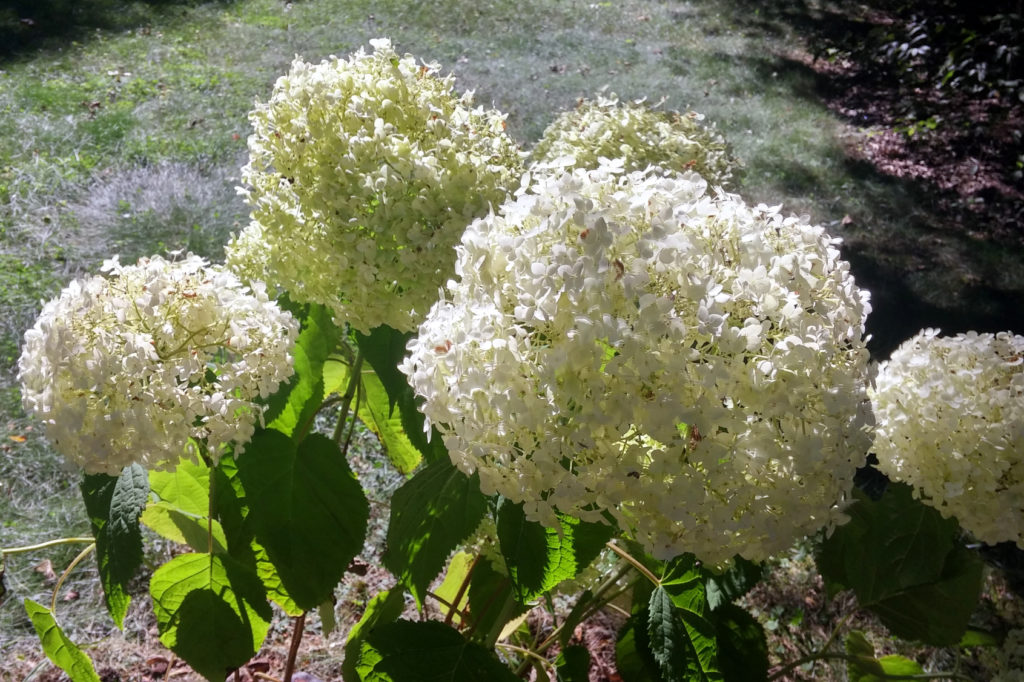
Note the size of the petals. They are small, much smaller than the hydrangeas you will find in most garden stores. The large petaled hydrangeas are not native to Maryland.
This summer has been busy and hot, and I did not get as much done with my garden as I wanted. I have been at war with some kind of insect (not any of the usual suspects with the usual solutions, I’m afraid) that is eating my roses to death. That rose garden has been nothing but trouble for me since I moved in, to be frank. There’s the insect infestation that will not be subdued, and then the crab grass and weeds are effluvient and eternal. I direct my attention away from it for as little as three days in a row and it’s as if a horticultural apocalypse occurred. But I digress.
Despite the rose/insect/weed problem and the heat (and all the other personal stuff that has no place on my garden blog), I was able to work on three sections of my garden since my last post. My biggest success, however, was finding a wonderful native plant nursery only 30 minutes away from my house. Last month I visited the nursery, and $245 later, well, I had to get these beauties in the ground before they dried up or blew away (weird weather this year, amiright?).
Remember that nasty mostly-dead row of cedars I pulled out earlier this year? Behold, the replacement:
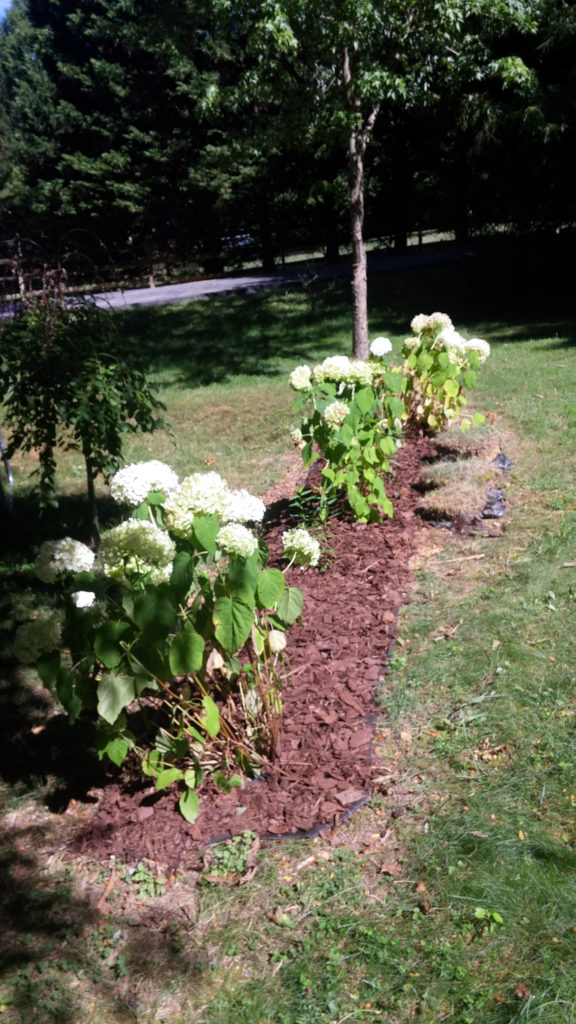
The big white puffy flowers are smooth hydrangeas (the hydrangea species native to Maryland). Swamp milkweed and butterfly weed (difficult to see here) are interspersed between them.
You might notice that the hydrangeas are not evenly spaced. This was neither by design nor carelessness. It is due of the presence of large tree roots, the great challenge of planting in a mature landscape. I did not wish to harm any of the nearby trees by damaging their roots, so I had to dig around them and modify my planting schema accordingly. I did say I was going for a natural look, though, right? So this lay-out is, uh, part of that aesthetic. Yeah.
Hydrangea Butterfly Garden
The purpose of this mini garden is to attract butterflies, so I planted three kinds of flowers that should do the job: white smooth hydrangeas, swamp milkweed, and butterfly weed. Though the hydrangeas are already large, the smaller milkweed and butterfly weed should grow to match the hydrangeas’ size in a couple of years.
Since planting this garden a few weeks ago we have had many butterfly visitors. Eastern tiger swallowtail, monarchs, and black swallowtails are the ones I know the names of, but there have been others as well. Three days ago I spotted two monarch caterpillars on the milkweeds, so it looks like the next generation will have a home here as well. 🙂
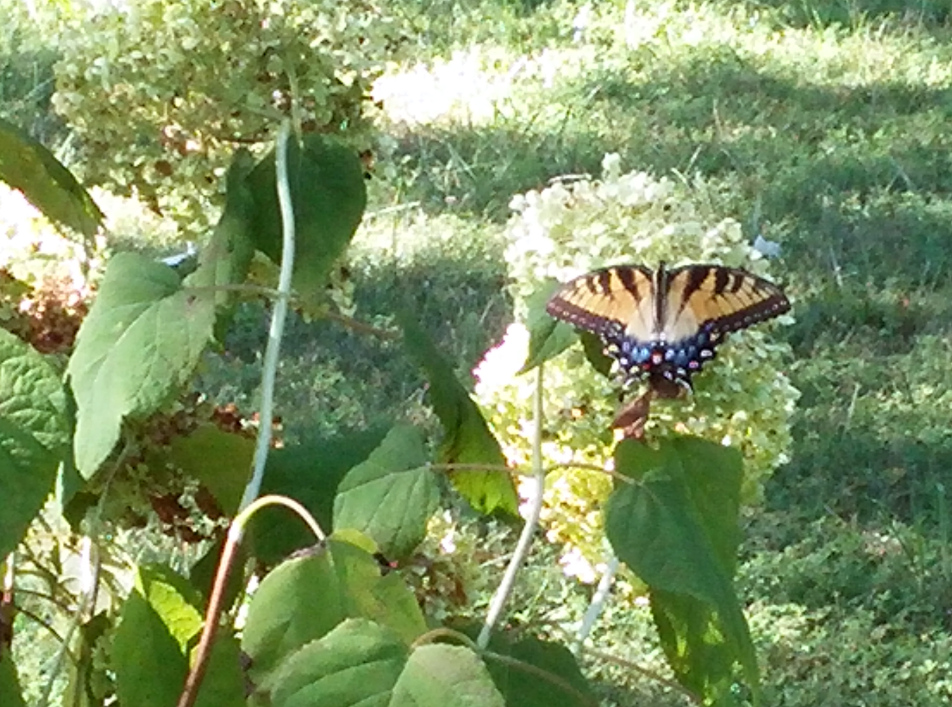
Two Other Garden Areas
I was also able to plant up two other garden areas, but I don’t have any pictures of them yet. Hopefully I’ll be able to update with pictures in a few days.
In one of these garden beds I’m going for a red and yellow theme, so I planted eastern columbines and cardinal flowers. These flowers are spring bloomers, however, so they are uninteresting at the moment. The other garden bed is where I’m putting my pinks, purples, and blues, so I planted blue flag iris (also a spring bloomer) and gayfeathers (Liatris). The gayfeathers are in bloom and look like something out of a Dr. Seuss book, so I really need to get pictures of them before their bloom season is over.
Garden Goods and Garden Garbage: Creepers vs Poison Ivy
I like a natural looking garden. I’ve said it before; I’m sure I’ll say it again. I have several garden beds that reflect this love of the wild and untamed beauty of Nature’s own design.
Take this iris bed, for example:
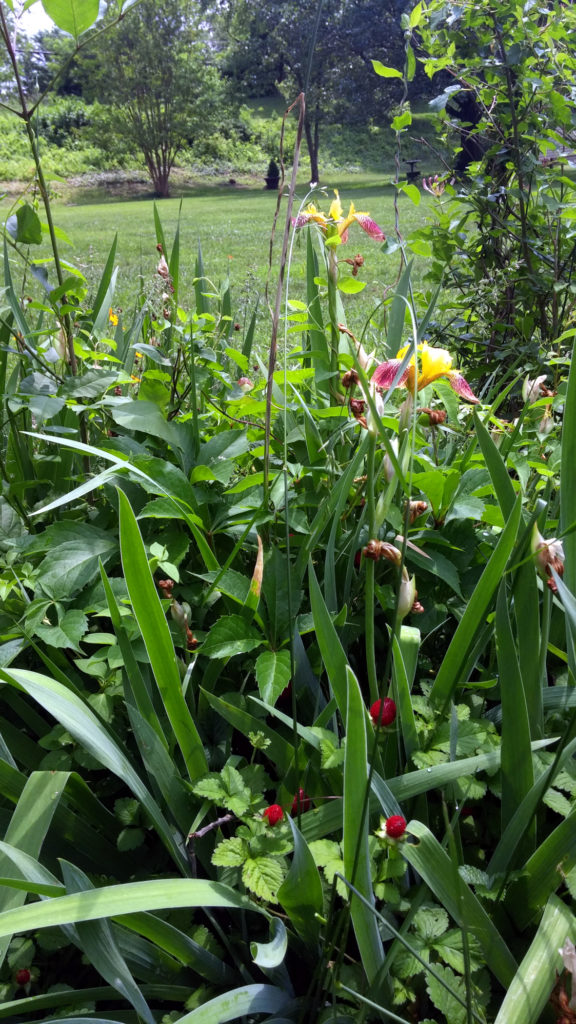
The wild strawberries moved in among the irises, and the bright red berries entice the eye in a sea of green foliage that might otherwise be boring. Even though this bed is a bit crowded and in need of thinning, the overall aesthetic of the wilderbed is one I enjoy and admire. The juxtaposition of Order (the green lawn) and Chaos (the wilderbed) offers a high contrast viewing experience. It is to me both visually exquisite and viscerally resonant. To wit:
Order is boring. Chaos is confusing. The two together are magic.
So perhaps you can understand my disappointment when the beautiful vines I found growing up my trees and around my pond and through my wilderbeds were a native nasty that could not be allowed to stay.
Its name?
Poison Ivy
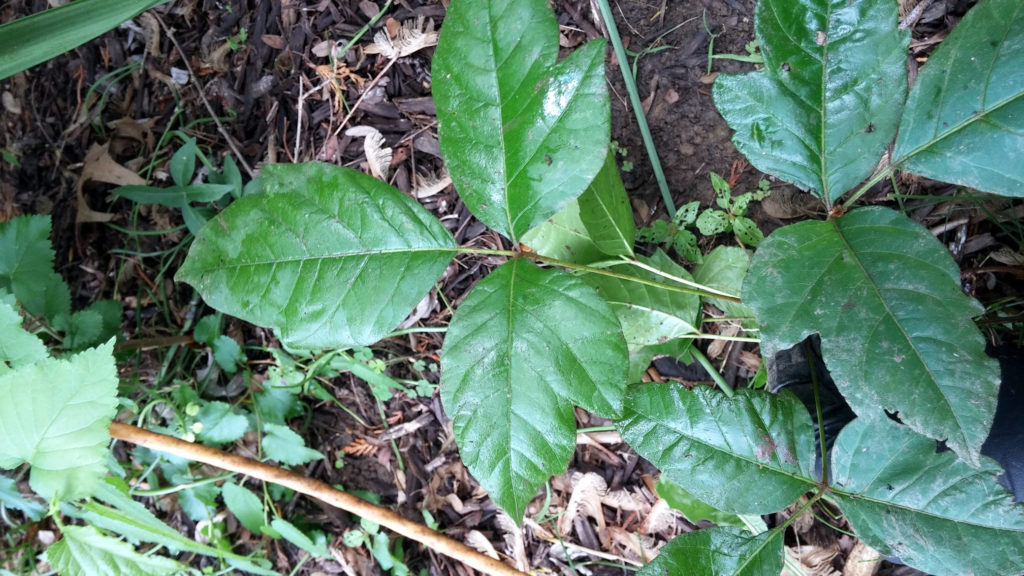
Oh why, oh why-vy
Are you so itchy and so slivy?
Did you have to come to my hive-y?
Oh, poison ivy.
I can’t let you stay alive-y.
For your death I must strive-y.
Now it’s time to say good-bye-vy,
Poison ivy.
Poison Ivy is a woody vine with smooth OR slightly scalloped dark green leaves that grow in bunches of three (trifoliate) with a dollop of deep red where the leaflets connect. That red is a sign of things to come, for when the autumn sun shines, these leaves turn a brilliant scarlet. Poison ivy is a beautiful plant. Ah, cruel beauty! It’s a shame it’s also hazardous to humans.
Urushiol, a skin-irritating oil, is the culprit. It causes a severe allergic reaction in most people, though about 15 percent of the population are resistant to it. Resistant, not immune. An important distinction. Even if one falls into the lucky 15 percent, repeated exposure to urushiol can weaken that resistance, so it is always beneficial to tread carefully when dealing with poison ivy.
Poison Ivy Disposal
Getting rid of poison ivy is tricky. You don’t want the poison ivy to make contact with any part of yourself. I wore long pants and a sweatshirt (which was too hot for this time of year, but whatever) and latex gloves to pull the devil vine out, roots and all.
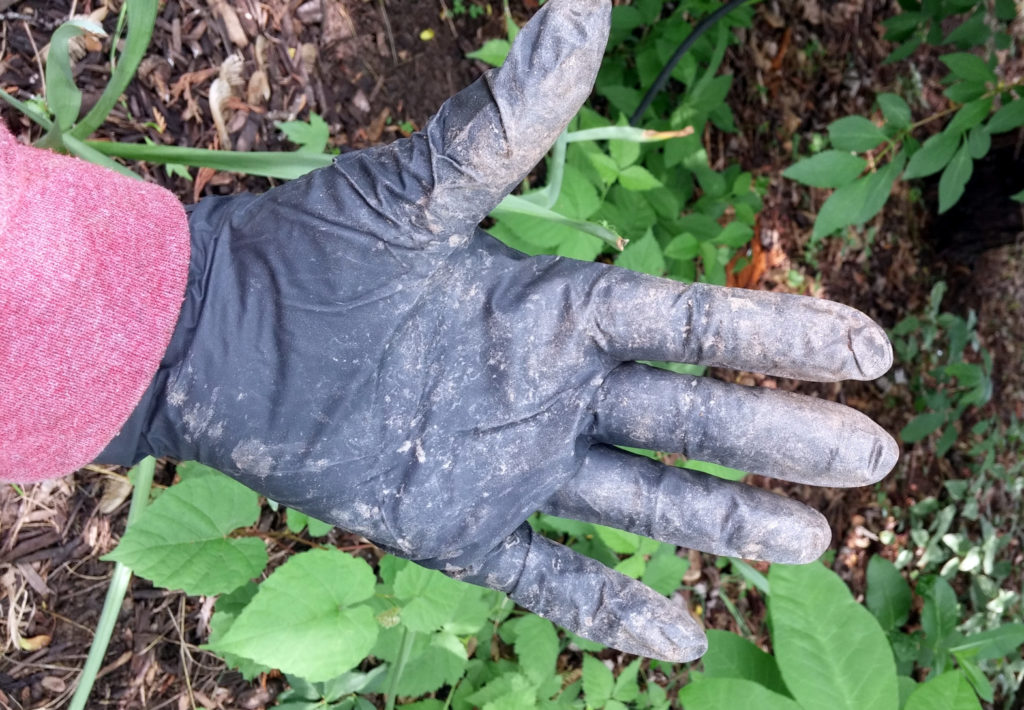
The other aspect that makes removing poison ivy tricky is that it has three highly effective survival properties. Poison ivy 1) spreads by rhizomes (subterranean stems, or creepers); 2) regrows from root clusters (roots that transform into stems, basically); and 3) is propagated by seed. This means that:
1) Poison ivy rhizomes spread everywhere, underneath the soil, so even if you think you got all of it, there is probably more several feet away (ad nauseam).
2) If you do not pull out or kill the entire root, poison ivy will grow back.
3) Even if by some miracle you are able to remove or kill the poison ivy plants in their entirety, a bird could eat poison ivy berries from somewhere else and poop the seeds back into your yard and infect your garden once more. So much fun.
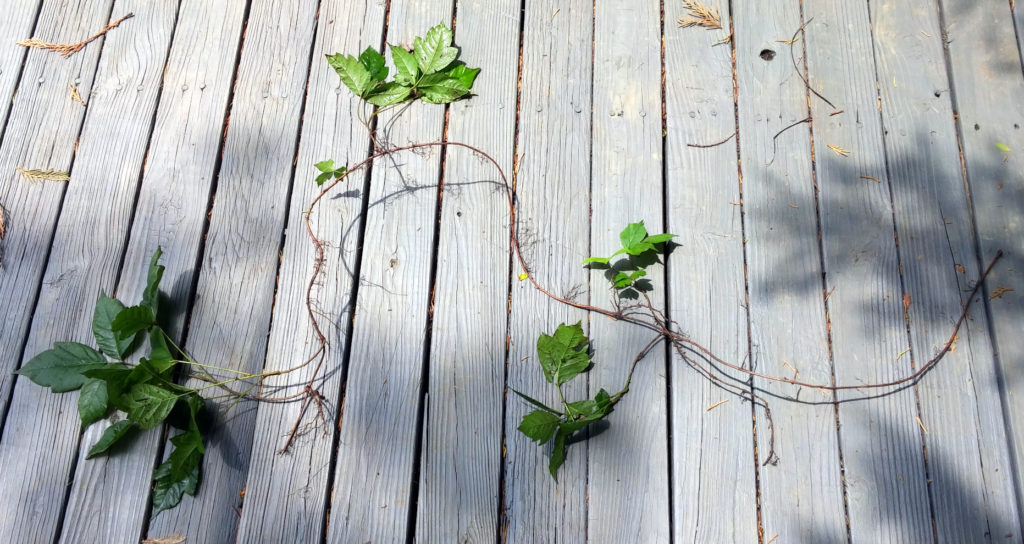
Only the bits with leaves were above ground. This was not the longest thread of poison ivy I removed either. I pulled others that were easily three times this length.
So I decided to brute-force pull up all the poison ivy in my garden. That means I located all the visible leaves; followed the maze of rhizomes and pulled them up; dug around the roots for purchase and pulled them up; and then tossed the remains into a garbage bag because that’s what poison ivy is: garbage. (And because the garbage bag will protect anyone else who comes in contact with it.)
It went to the landfill (vs yard waste pick-up or composting) because I did not want even a whiff of a possibility that the poison ivy will grow back from these cast-offs. I would normally advocate for options that keep landfill waste to a minimum, but this I don’t feel too bad about because poison ivy is organic matter and will decompose in the landfill.
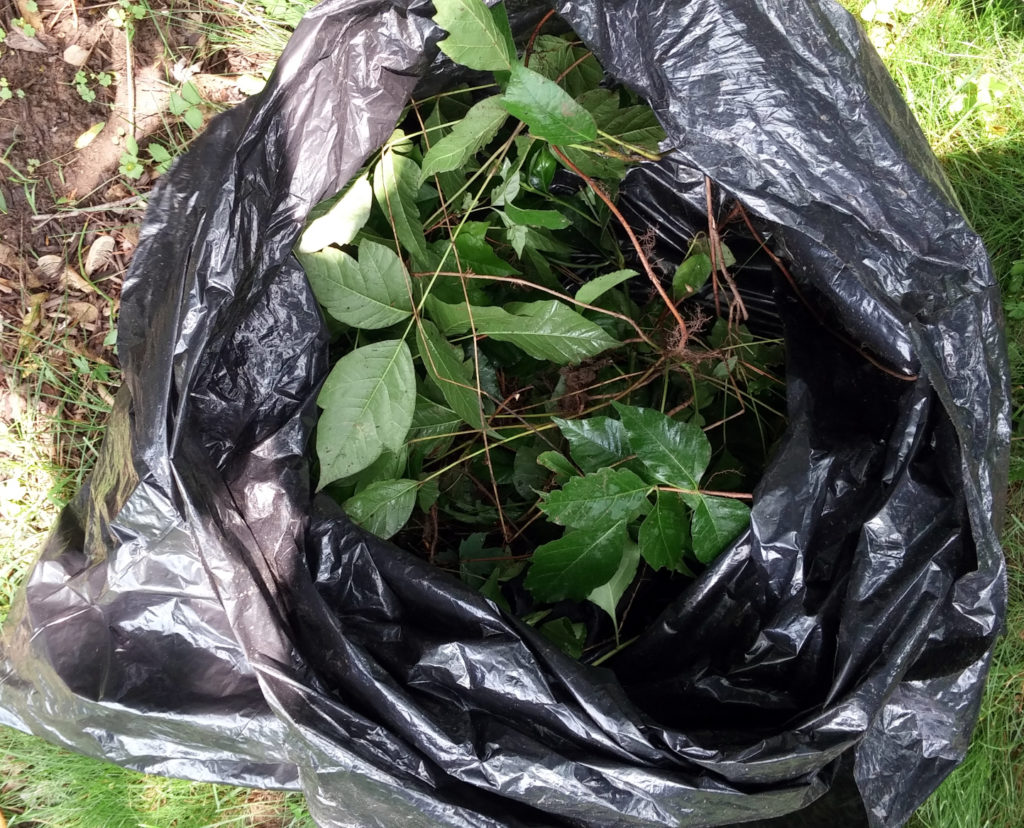
Chemical cures for (killing) poison ivy are available. I chose to stay away from chemical solutions, however, because of the inevitable collateral damage. Poison ivy likes to grow in areas like the one pictured below, and because of the twining, twisty, tricky, sticky way poison ivy grows, I did not have confidence that the killing agent would affect ONLY its intended target and NOT KILL the plants I wanted to keep.
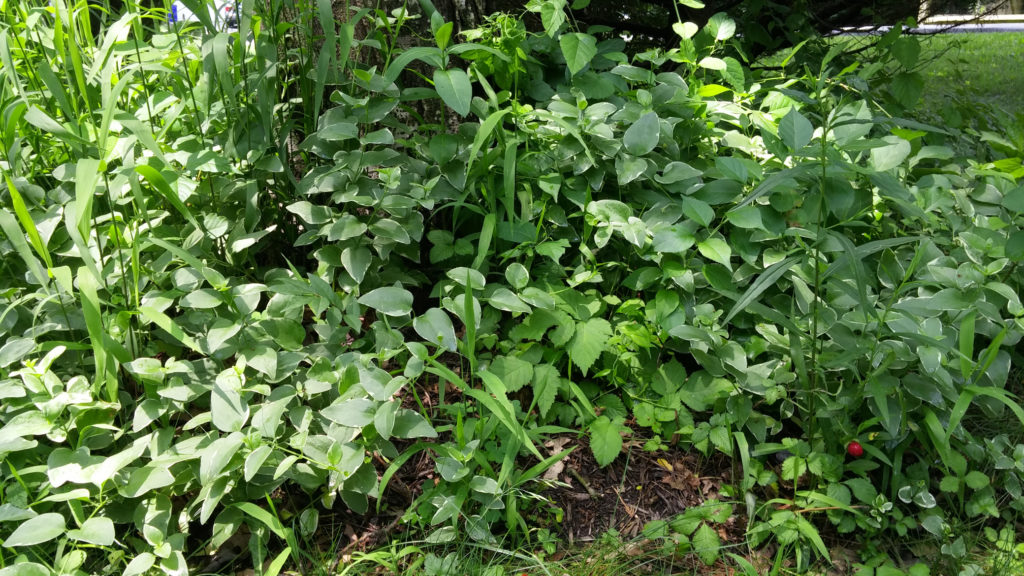
Creepers Worth Keeping
Poison ivy is not the only creeper found in gardens, and some of them are worth keeping. Wild strawberries are one. I’ve mentioned them already. I love wild strawberries and encourage them to grow throughout my garden.
Virginia creeper and wild raspberry are others. Both are often mistaken for poison ivy, and many a gardener ends up pulling them out too. If you are going for a cleaner, more controlled aesthetic, or you have some plantings that can’t be crowded, then sure, pull them out when you find them. But if, like me, you want that natural look and are inclined to vines, then you can’t go wrong with Virginia creeper and wild raspberry. They make great additions to the garden and provide that hint of chaotic interest that I am so fond of. They do require thinning from time to time, however. Otherwise they might choke out anything less robust than themselves.
Virginia Creeper
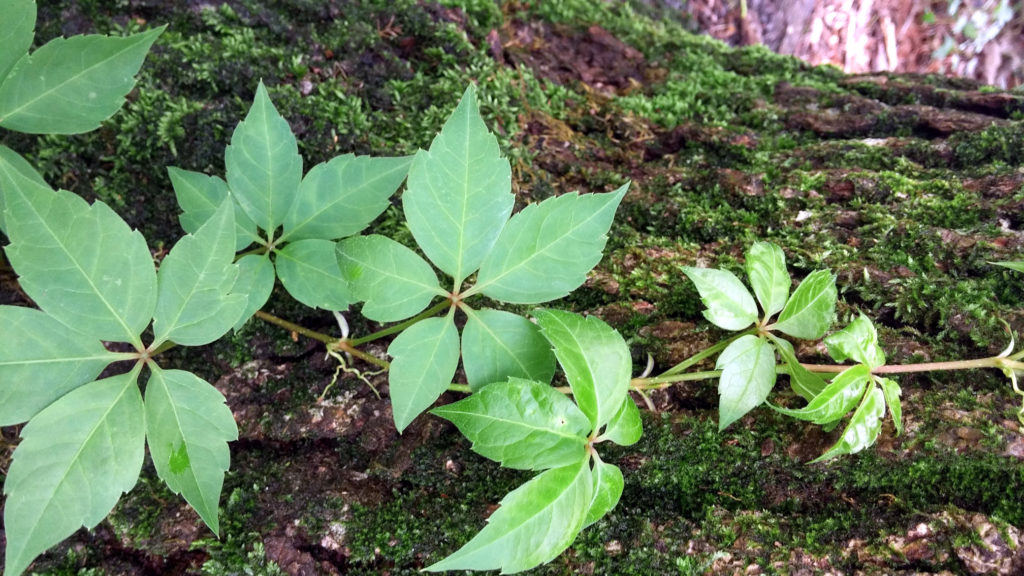
Note the shape and color of the leaves. They are almost identical to poison ivy, and it is easy to see how Virginia creeper could be mistaken for its more toxic cousin. However, Virginia creeper leaves grow in groups of five (quinquefoliate), which makes it easy to distinguish between the trifoliate poison ivy. Like poison ivy, Virginia creeper’s autumn transformation is quite stunning, going from green to bright red.
Now a small word of warning; Virginia creeper is part of the grape family and does produce berries that are harmful if ingested. Likewise, the rest of the plant contains raphides, which can irritate the skin for some people.
Wild Raspberries
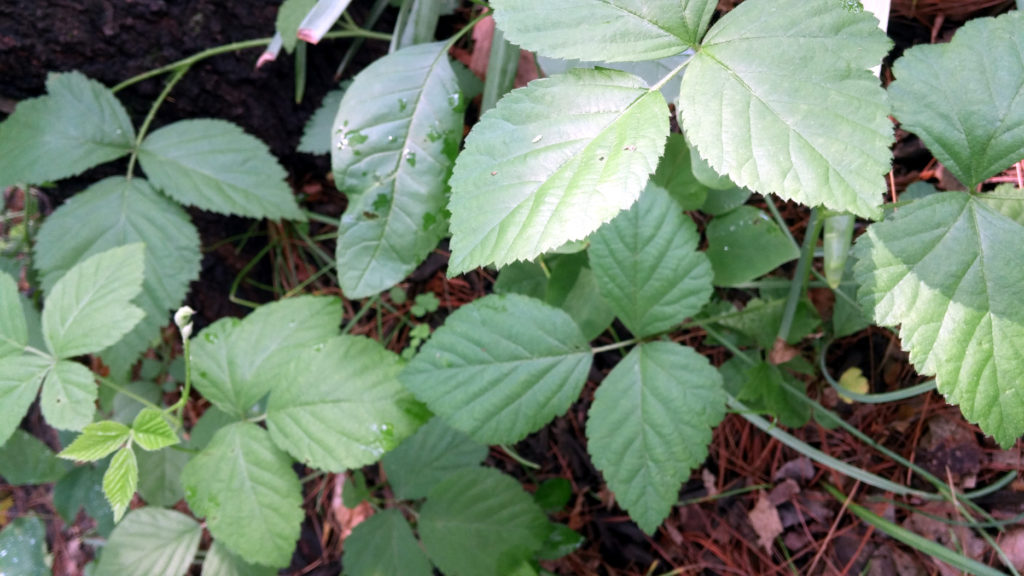
Cluster of three leaves: check. Creeper: check. Green: check. Grew out of nowhere: check.
The similarities to poison ivy are many. However, wild raspberries are usually a lighter green than poison ivy (though young poison ivy leaves are lighter than their mature counterparts). Wild raspberries can have clusters of three or five leaves, and those leaves are toothed, or serrated, unlike the smoother scallop of poison ivy. The biggest difference between the two, however, is that wild raspberries have what most people refer to as thorns.
Botanically, pedantically, these “thorns” are really prickles and are differentiated from proper thorns in that prickles sit on the surface and are a feature of the plant’s epidermis or bark whereas thorns are modified stems.
TANGENT: Raspberries and roses are in the same family (Rosaceae). That means (you guessed it) that roses don’t have thorns either. That’s right, roses have prickles. But for practical purposes, it’s okay to call them thorns. We all do, even those who know better.
The berries each produce are also quite different from each other. Wild raspberries can range in color from white to yellow to red to black. They look plump and inviting. Poison ivy berries are small, gnarly, dumpy whitish, and look disgusting.
I’m looking forward to autumn. I can’t wait to enjoy the fruits of the wild raspberries and the bright red bursts of the Virginia creepers. But for now, I’m happy with the wilderbed Mother Nature and I created. It has a summer woodland glade aesthetic that is free from poison ivy. For now.
Sprouting Saplings
Although all of the bare root trees I planted have sprouted leaves now, I decided not to include pictures of all of them for two reasons: 1) repeats of the same kind of tree are extraneous; 2) due to the surrounding greenery, some of the sprouting foliage blends into the background and cannot be seen well anyway. (I guess a distant third would be that I’m saving myself time and effort. Shhh.)
REDBUD

ELDERBERRY
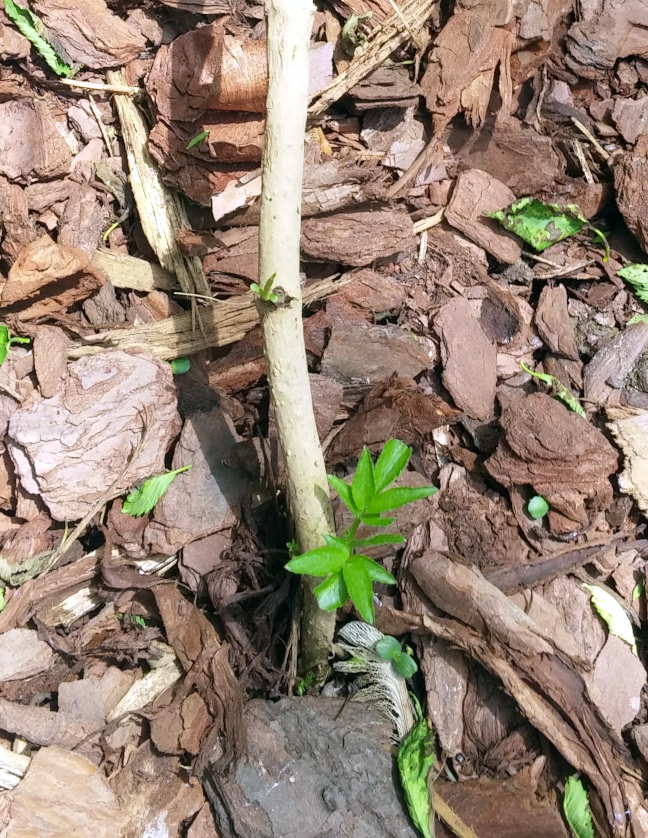
NOT PICTURED
Sweetbay Magnolia
Dogwood
The Waiting
Like most writers, I have always enjoyed writing. My mother taught me to keep a journal since the time I could hold a pencil, and I faithfully recorded the things of my life that meant the most to me, and even the things that meant nothing. It was and is a valuable part of my life.
I didn’t enjoy reading until the summer after 5th grade. That summer I discovered worlds I had only hoped, somewhere, existed. I discovered the parts of humanity that I had never seen, the good and the bad. I discovered stories that made me feel. I discovered in myself a desire to create my own.
And I did.
Writing was a hobby I enjoyed, something I did for myself. Until a few years ago, I never dared believe that I could take my writing—No—that my writing could take me anywhere else. But then one day as I read a book, a thought, insidious in its way, took hold in my mind: Why not me?
So I did one of the hardest things I’ve done. I wrote a novel of 105,000 words in a year, and I did it during nap times and between work and familial obligations. I sacrificed sleep and professional opportunities and personal satisfactions, and I asked myself: Was it worth it?
I didn’t have an answer then.
The editing began. I laid my heart bare in my manuscript, and I subjected it to the harsh but necessary criticisms of others. It hurt. But growing beyond our current capacity, bursting that which contains us, hurts. When the hurting was done, I looked at what I had wrought, and I thought: Yes. This was worth it.
The first rejection hurt more than I thought it would. I was expecting it, you see, because most manuscripts are rejected (several times) before they are accepted. I was expecting it. But I suppose my hope was greater than I knew.
It was a good rejection. I have since learned that there are such things. The publisher told me that my manuscript would not be financially successful for them, but they asked me to send something else if I had it.
I didn’t. 🙁
I had spent five months waiting in nervous anticipation to hear “No”.
I sat on my manuscript for a year then. Tweaking it, improving it, but mostly I started working on something else. Another novel. A short story or two. I submitted my good short story to a magazine. Their auto-responder told me that, due to the amount of submissions, it would be eight months before I heard back.
That was two months ago. The waiting is not something I was ready for when I decided to embark upon the Writer’s Path. Waiting is stressful, it’s hard, but it’s necessary and understandable, and it’s annoying that it’s necessary and understandable. We all have a certain amount of time in this world, and for writers it’s inevitable that some of it must be spent waiting.
And I’m ready now. I’m ready for the waiting this time. I did my research, and I’m not taking a shot in the dark. I’m submitting my manuscript again. I hope for the best but I know what to expect.
Was it worth the waiting?
Everyone who has passed through it says yes. I’ll let you know when I’ve passed through it too.
In the beginning…
…was the word. And that’s as far as I’ve gotten.
Word.
